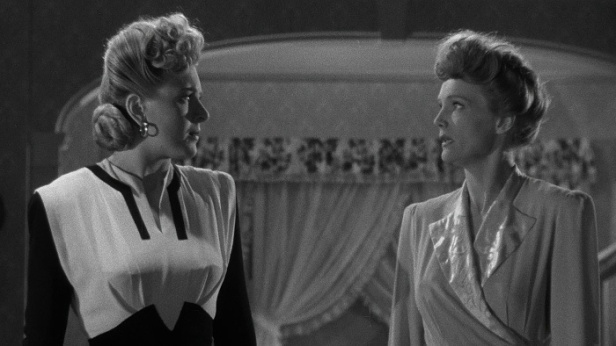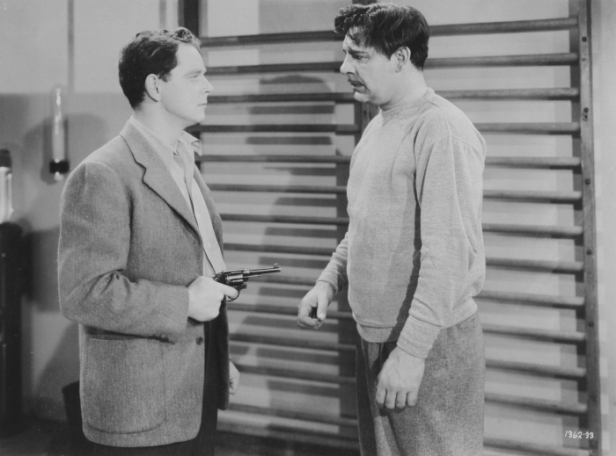Of all of the Inner Sanctum films, this second instalment, directed, as was its predecessor Calling Dr Death (1943), by Reginald LeBorg, is the one that might perhaps most legitimately be labelled a horror film. It was based on Fritz Leiber’s 1943 novel Conjure Wife, which also served as the basis for Sidney Hayers’ far better Night of the Eagle (1962). On its own terms though, Weird Woman is surprisingly good, easily the best of the Inner Sanctum films even if it does fillet the original story and strip it down to only its bare essentials.
Chaney, again required to whisper his inner monologues by Brenda Weisberg’s script (though far less so than in Calling Dr Death) plays Norman Reed, a sociology professor at Monroe College. He’s recently published his latest book, Superstition Versus Reason and Fact, but is more concerned about his future wife Paula (Anne Gwynne), the daughter of American missionaries who was raised by Laraua (Hanna Kaapa), the high priestess of Kauna-Ana-Ana on a remote South Seas island where belief in voodoo is very real. Former lover Ilona Carr (Evelyn Ankers) is so enraged that Reed has rebuffed her (Chaney makes for a sex symbol even more unlikely than his tormented academic) and accuses Paula of being a “witch wife” who has been using her magical powers to secure Reed’s success. Ilona is supported by faculty staff members Evelyn Sawtelle (Elizabeth Russell) and her husband Millard (Ralph Morgan) and together they try to turn Reed’s adoring student Margaret Mercer (Lois Collier) against him. But Reed has bigger things to contend with when he follows Paula on one of her nightly disappearances only to find her performing a voodoo ceremony aimed at harming Ilona. His subsequent destruction of Paula’s fetishes and trinkets, her “circle of immunity,” leaves the couple vulnerable to supernatural forces.

Ankers gets her only really villainous role here and it’s not hard to see why she so infrequently took the femme fatale role. She’s a treasured fixture of 40s Universal horrors but she was fare better suited to playing screaming victims than she was playing a treacherous snake like Ilona, never once convincing us that she’s as bad as she appears to be. But she’s still head and shoulders above Chaney who is still horribly miscast in a role that was quite beyond his abilities, and he’d remain so throughout the entire Inner Sanctum series. It beggars belief that all these women are completely obsessed with the dour Reed (“He’s the most brilliant man on the campus!” coos Margaret), almost as if he’s the one using some sort of magic to exert an influence over them.
More so than Calling Dr Death, which had been scripted by Edward Dein, one of the writers of Cat People (1942), Weird Woman owes a debt or several to the subtle shockers that Val Lewton was overseeing at RKO. It feels akin to I Walked With a Zombie (1943) but lacks any of the atmosphere of that film and certainly has nothing as unsettling as the encounter with Darby Jones’ Carrefour in the cane fields in Jacques Tourneur’s film. There is a creepy graveyard scene but it’s not all that memorable.

Weisberg’s script is the saving grace here, full of nice little in-jokes (a professor is jokily reprimanded with “you seventh son of a seventh son” and Grave tells Ilona “there’s something about your smile right now that makes me think of Jack the Ripper”) and flowery dialogue that often proves highly amusing though whether it was meant to be is up for debate: “Why David,” purrs Ilona, “didn’t you know that night is the special domain of great minds? History is made at night they say. Poetry is born at night.” It’s hard to know what to make of dialogue like that. Overall, Weisberg does a decent enough job of adaptation, streamlining some aspects of Leiber’s story (the rival witches on campus are gone) while adding extraneous new material (a studio-bound flashback to a native ritual on the island).
Night of the Eagle may do it more justice, but Weird Woman is an interesting if underachieving take on Leiber’s novel that just about keeps the attention throughout it’s just-over-an-hour running time. It’s flawed but go with its absurdities and you’ll have fun with it, more so than you will with any of the other Inner Sanctum entries. But again, one wishes that it had been made by a better director, afforded more time and money and with the care and attention lavished on Universal’s 30s Gothics. Other versions of the story include an episode of the television series Moment of Fear broadcast on 8 July 1960 and the awful 1979 film Witches’ Brew.